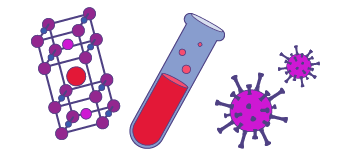Dynamic nuclear polarization (DNP) has been demonstrated to increase the sensitivity of NMR experiments by several orders of magnitude, which can lead to additional information about the systems being studied and drastically reduce experimental acquisition times.
Dissolution DNP uses microwave radiation to transfer the high polarization of electron from stable radicals to low abundance NMR active nuclei like 13C, 15N in molecules of interest thereby increasing the number of polarized nuclear spins tremendously and enhancing the signal to noise ratio by up to three orders of magnitude. The signal enhancement makes it possible to study biochemical phenomena and diseases in real time in vivo by 13C NMR/MRI.
Typically, a sample containing the metabolite of interest (e.g. pyruvate, lactate) and stable radical is frozen, and then irradiated by microwave radiation in the DNP apparatus at ≤1.2 K for approximately 1 hour. The sample is then rapidly melted and transferred to an automatic injection device using a heated buffer solution, where it can be introduced into the tissue, organ, or cell culture to be studied. The hyperpolarized signal can then be observed for 3 - 5 minutes after the dissolution process has been initiated.
In the AMRIS Facility in Gainesville, FL, a dissolution DNP polarizer operating at 5 T/140 GHz has been built for in-vivo, ex-vivo, and in-vitro MRI/S studies. The polarizer is custom built, with a tuneable microwave source, which also allows for solid-state studies of the polarization dynamics. It has been designed as a platform for both methodology development and in-vivo metabolic studies via MRI/S at both 4.7 and 11 T, and ex-vivo/in-vitro studies at 14 T.

Explore our magnet schedule to see what exciting research is happening on our stellar fleet of instruments right now.
Last modified on 08 March 2023